Apraxia of Speech Goals:
Looking for speech therapy goal ideas for childhood apraxia of speech (CAS)?
You’ve come to the right place!
This page contains sample speech therapy goals for children with childhood apraxia of speech. Plus, we’ll show you how to target those goals in therapy or during home practice.
What is Childhood Apraxia of Speech (CAS)?
CAS is a rare, neurologically-based speech disorder where the child knows what he wants to say but the message gets mixed up in the motor planning and execution phase so the sounds come out all wrong.
Imagine it’s like you’re driving your car and you know you’re going to turn right so you turn on your right turn indicator (or blinker). But then, for some reason, your clock starts flashing instead of your turn indicator light (true story: I once had a car that did this). So you think, “Well that wasn’t what I wanted to happen” and you try again. This time, your trunk pops open! Imagine how frustrating that would be!
That’s exactly how speech feels for children with CAS. They know what they want to say and they tell their mouth to say it but it just comes out all wrong.
How is Childhood Apraxia of Speech Diagnosed?
Since CAS is still a relatively new diagnosis, there are no standard diagnostic criteria for determining if a child has it or not. That can make it very difficult to know for sure if this is the right diagnosis. From what we can tell, though, most clinicians agree that these three common features should be present for the diagnosis:
- Inconsistent errors on consonants and vowels in repeated productions of syllables or words (meaning that if the child says the same word many times, it may sound differently each time).
- Lengthened and disrupted coarticulatory transitions (meaning that the child’s speech sounds choppy or disconnected due to trouble transitioning between sounds or between words in older children).
- Inappropriate prosody, especially in the realization of lexical or phrasal stress between sounds and syllables (meaning that the rhythm, intonation, and stress of speech may sound off, the child may sound robotic, have incorrect phrasing, or stress the wrong words or syllables).
Other Signs of Childhood Apraxia of Speech (CAS)
These other symptoms have often been noted in children with CAS but don’t HAVE to be present for the diagnosis to be made:
- Reduced vowel inventory
- Vowel errors
- Increased errors in longer or more complex syllable and word shapes (especially omissions, particularly in word-initial position)
- Groping
- Unusual errors that “defy process analysis”
- Persistent or frequent regression (e.g., loss of words or sounds that were previously mastered)
- Differences in performance of automatic (overlearned) versus volitional (spontaneous or elicited) activities, with volitional activities more affected
- Errors in the ordering of sounds (migration and metathesis), syllables, morphemes, or even words
Childhood Apraxia of Speech Goals:
Although therapy for each child will be individual to that child’s particular needs, we must consider and include these 4 components in their treatment (along with any other problems the child may be having):
- Speech Sound Production
- Language Development
- Augmentative-Alternative Communication (AAC) – if necessary
- Prosody
Childhood Apraxia of Speech Goal 1:
Speech Sound Production
This is the first component of therapy for children with CAS and often the first one that we think of. For this skill area, you will work on improving the child’s ability to speak speech sounds clearly and in increasingly long utterances. Childhood apraxia of speech is different than other speech sound disorders in that the problem lies in the motor planning of the speech sounds. For that reason, it helps to start with shorter words and gradually build your way up (with lots of repetition).
Here is an example of a hierarchy that you could move through to teach a child with childhood apraxia of speech to produce increasingly longer words/utterances. *NOTE: This should be used as a starting point as not all children will follow this order. Customize this to the needs of the clients you are working with.
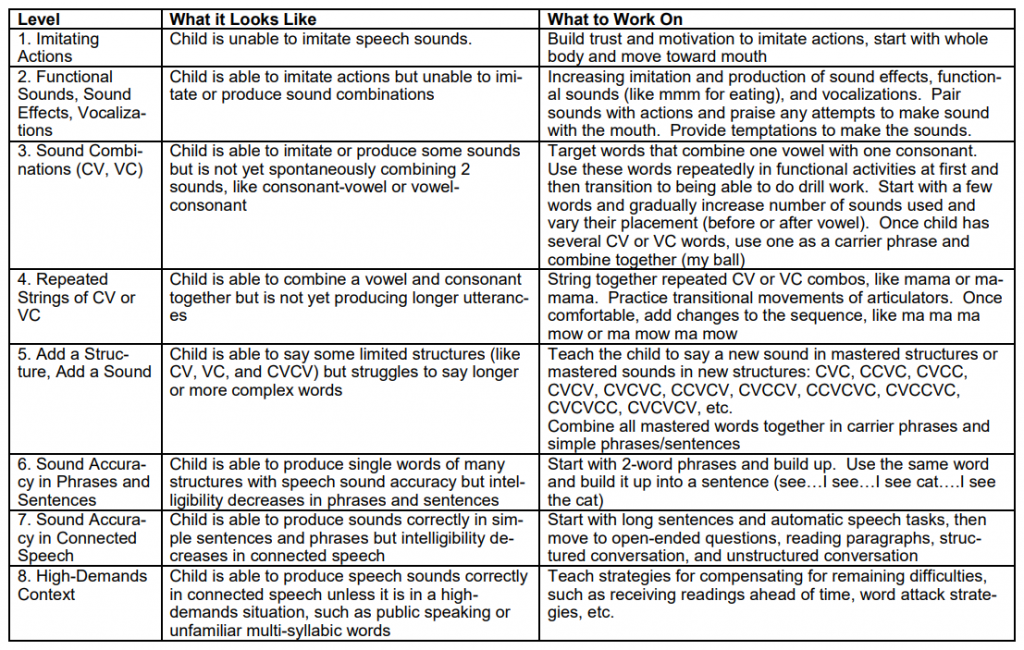
Childhood Apraxia of Speech Goals
Speech Sound Production
Use these sample goals for CAS as a starting point for writing your own goals based on the child’s level:
- Imitating Actions: Client will imitate actions from in the therapy setting with at least 80% accuracy on 3 consecutive data collection days.
- Functional Sounds, Sound Effects, Vocalizations: Client will produce or imitate sounds with his mouth using sound effects and basic vocalizations (like making animal and vehicle noises or saying “mmmm” for a yummy sound) at least 20 times during 15 minutes of play with the speech-language pathologist.
- Sound Combinations (CV, VC): Client will produce both sounds in consonant-vowel (CV) and vowel-consonant (VC) words (such as, “me”, “no”, “hey”, “hi”, “bye”) to label pictures or for functional communication on at least 80% of observed attempts.
- Repeated Strings of CV or VC: Client will produce both sounds in reduplicated consonant-vowel-consonant-vowel (CV) words (such as, “mama”, “dada”, “no no”) to label pictures or for functional communication on at least 80% of observed attempts.
- Add a Structure, Add a Sound: Client will produce all sounds in CV, VC, CVC, and CVCV words to label pictures or for functional communication on at least 80% of observed attempts (age appropriate sound substitutions will be allowed).
- Sound Accuracy in Phrases and Sentences: Client will produce all sounds in CV, VC, CVC, and CVCV words in short sentences on at least 80% of observed attempts (age appropriate sound substitutions will be allowed).
Childhood Apraxia of Speech Goal 2: Spoken Language
The goal of this skill set is to improve a child’s willingness and ability to use speech functionally in the natural environment. Speech sound accuracy is not the primary goal for this hierarchy (though it is encouraged), so close approximations of words are accepted and encouraged.
Again, here is a sample of how you might step a child through using language for functional communication with a child with childhood apraxia of speech. Use this as a starting point but customize it to what the child needs.
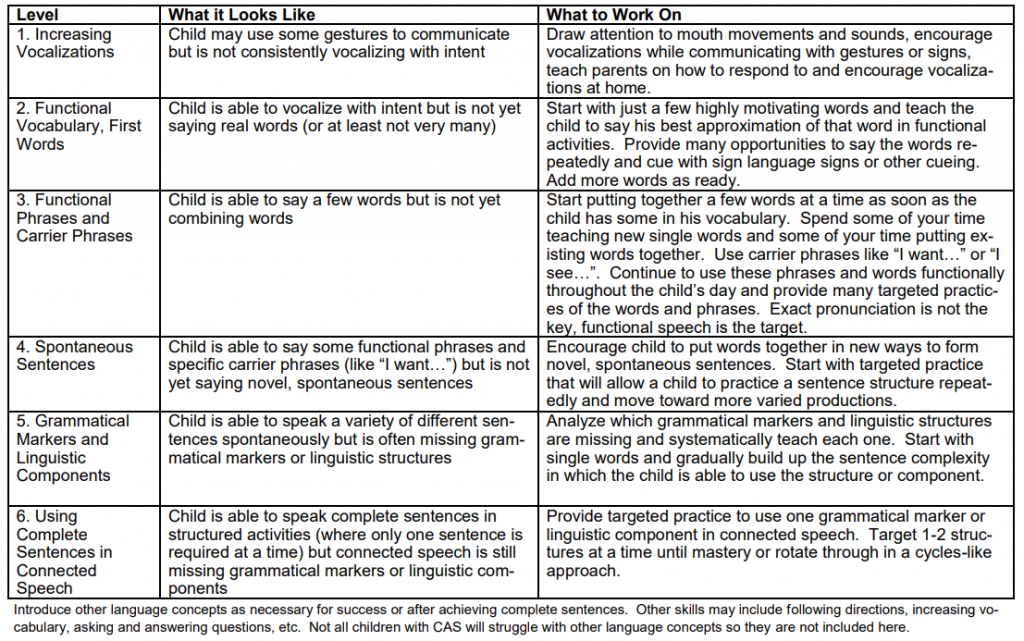
Childhood Apraxia of Speech Goals
Spoken Language
Use these sample goals as a starting point to helping a child with CAS or Suspected CAS to use spoken language for functional communication.
- Increasing Vocalizations: No goal for this step, this is a therapy strategy that will be implemented to encourage vocalizations.
- Functional Vocabulary, First Words: Client will produce spoken single words or word approximations to intentionally communicate with the therapist at least 20 times during a 15-minute therapy session on 3 consecutive data collection days.
- Functional Phrases and Carrier Phrases: Client will imitate or produce words or word approximations in short carrier phrases (such as “I want ___” or “I see ____”) to intentionally communicate with the therapist at least 20 times during a 15-minute therapy session on 3 consecutive data collection days.
- Spontaneous Sentences: Client will imitate or produce 4-5 word sentences (sound errors acceptable) at least 20 times during a 15-minute therapy session on 3 consecutive data collection days.
- Grammatical Markers and Linguistic Components: Client will correctly use the following grammatical marker/linguistic components in sentences while describing pictures in the therapy setting with at least 80% accuracy.
- Using Complete Sentences in Connected Speech: Client will use grammatically complete utterances during conversation with the therapist with no more than 10 grammatical or word order errors in 15 minutes of therapy on 3 consecutive data collection days.
** Introduce other language concepts as necessary for success or after achieving complete sentences. Other skills may include following directions, increasing vocabulary, asking and answering questions, etc. Not all children with CAS will struggle with other language concepts so they are not included here.
Childhood Apraxia of Speech Goal 3: Prosody
The goal of this skill set is to improve prosody skills in children with CAS, including rate, pitch, and volume. These skills are often impaired in children with childhood apraxia of speech but they won’t look the same in every child. Analyze what challenges the child is having and choose the skills from the chart below that best fit that client’s needs.
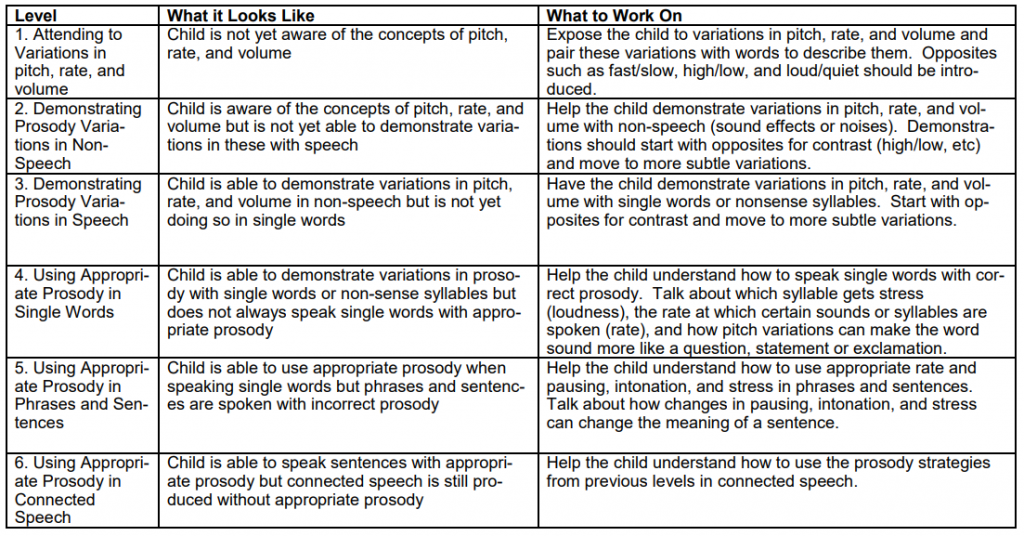
Childhood Apraxia of Speech Goals
Prosody
Use these sample goals as a starting point to helping a child with CAS or Suspected CAS improve prosody.
- Attending to Variations in Pitch, Rate, and Volume: The client will attend to several sounds in the environment (or recorded) and use at least 2-words to describe the sound (e.g. loud [volume], soft [volume], high [pitch], low [pitch], fast [rate], slow [rate] in 8 out of 10 opportunities on 3 out of 4 data collection days.
- Demonstrating Prosody Variations in Non-Speech: The client will demonstrate a variety of prosodic features (i.e. volume, rate and pitch) when producing non-speech sound (e.g. sound effects) in 8 out of 10 opportunities on 3 out of 4 data collection days.
- Demonstrating Prosody Variations in Speech: The client will demonstrate a variety of prosodic features (i.e. volume, rate and pitch) when producing single words or nonsense syllables in 8 out of 10 opportunities on 3 out of 4 data collection days.
- Using Expected Prosody in Single Words: The client will demonstrate expected prosody following a model when saying single words in 8 out of 10 opportunities on 3 out of 4 data collection days.
- Using Expected Prosody in Phrases: The client will independently demonstrate expected prosody (i.e. rate, pausing, stress and intonation) when saying phrases in 8 out of 10 opportunities on 3 out of 4 data collection days.
- Using Expected Prosody in Sentences: The client will independently demonstrate expected prosody (i.e. rate, pausing, stress and intonation) when saying sentences in 8 out of 10 opportunities on 3 out of 4 data collection days.
- Using Expected Prosody when Reading: The client will independently demonstrate expected prosody (i.e. rate, pausing, stress and intonation) when reading aloud 80% of the time on 3 out of 4 data collection days.
- Using Expected Prosody During a Structured Task: The client will demonstrate expected prosody (i.e. rate, pausing, stress and intonation) when completing a structured task 80% of the time with no more than 2 cues on 3 out of 4 data collection days.
- Using Expected Prosody during Spontaneous Conversation: The client will demonstrate expected prosody (i.e. rate, pausing, stress and intonation) 80% of the time with no more than 2 cues on 3 out of 4 data collection days.
Childhood Apraxia of Speech Goal 4: Augmentative/Alternative Communication (AAC) Use
The goal of this skill set is to provide a child an alternative means of communicating to relieve frustration and communicative pressure if speech is not adequate to do this. If a child’s speech is functional to communicate everything that he wants and needs to communicate in his natural environment, this hierarchy can be skipped. Or, this hierarchy can be abandoned once functional speech becomes adequate.
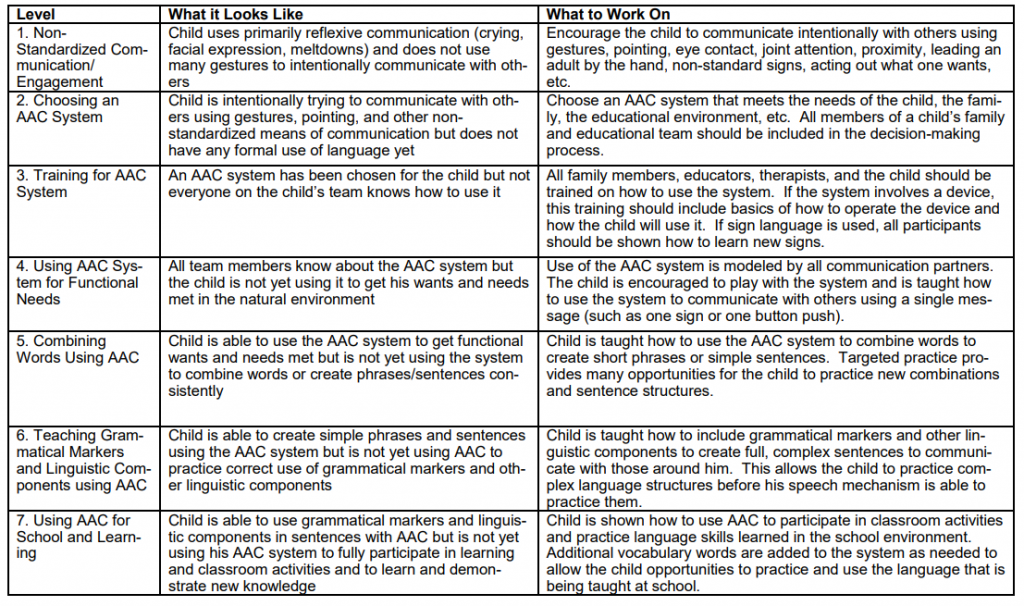
Childhood Apraxia of Speech Goals
AAC Use
Use these sample goals as a starting point to helping a child with CAS or Suspected CAS use AAC to communicate.
- Non-Standardized Communication/Engagement: Client will communicate intentionally with others using gestures, pointing, eye contact, joint attention, proximity, leading an adult by the hand, non-standard signs, acting out what one wants, etc. at least 10 times during 15 minutes of therapy.
- Choosing an AAC System
- Training for AAC System
- Using AAC System for Functional Needs : Client will use some form of language (spoken speech, sign language, or AAC) to intentionally communicate with others at least 10 times during 15 minutes of speech therapy on 3 consecutive data collection days.
- Combining Words Using AAC: Client will use some form of language (spoken speech, sign language, or AAC) to produce 2-word utterances at least 20 times during 15 minutes of speech therapy on 3 consecutive data collection days.
- Teaching Grammatical Markers and Linguistic Components using AAC: Client will correctly use the following grammatical marker/linguistic components in sentences while describing pictures in the therapy setting with at least 80% accuracy (any form of language is accepted: spoken speech, sign language, or AAC).
- Using AAC for School and Learning: Child is shown how to use AAC to participate in classroom activities and practice language skills learned in the school environment. Additional vocabulary words are added to the system as needed to allow the child opportunities to practice and use the language that is being taught at school. Additional goals can be written for participation in these classroom activities.
Where to Start:
I know this can seem overwhelming when you’re first starting out so keep in mind that you only need to work on one level from each of these four areas and you can even prioritize it down so that you’re just working on one or two areas at a time.
Also, keep in mind that this should be used as a framework for speech therapy and not a prescribed program or system. This method has not been tested by research and is just my interpretation of one way that these skills may be broken down. I have decided on this order based on my clinical experience and what I’ve read in the current CAS literature, but it is not backed by specific research. This is just an idea to get you started, but you should tweak it and modify it for each individual child.
Is there a program or curriculum I can use to treat apraxia of speech and other motor speech disorders in speech therapy?
Yes, the Motor Speech Curriculum by Speech and Language Kids is a structured program that speech-language pathologists and SLPAs can follow to help children with apraxia of speech and other motor speech disorders in speech therapy.
The Curriculum is based on evidence-based practices and breaks down therapy into phases that gradually build up success over time. Everything needed for therapy is included: skill progressions, tracking tools, therapy materials, training videos, support, and AI-powered material generators that will instantly generate additional practice materials tailored to a child’s interests and skill level.
A subscription to the SLK Curriculum also includes the Curriculums in other areas as well, such as language, social, fluency, etc.

About the Author: Carrie Clark, MA CCC-SLP
Hi, I’m Carrie! I’m a speech-language pathologist from Columbia, Missouri, USA. I’ve worked with children and teenagers of all ages in schools, preschools, and even my own private practice. I love digging through the research on speech and language topics and breaking it down into step-by-step plans for my followers.
Fun Fact: Every year, the Missouri Speech/Language Hearing Convention holds a quiz bowl style tournament for all of the colleges/universities in the state. The questions are all Praxis practice questions. I was the team captain for Truman State University the year we won against the University of Missouri team in triple overtime!
Connect with Me:

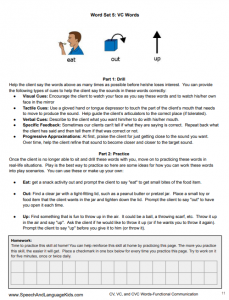


Hi! I was trying to download the CAS levels chart but it kept rejecting me. Would you be able to email me a copy at olaurae@gmail.com? Thank you!
Hi, Laura-We just emailed you a copy of the materials you were not able to download. Please let us know if you need anything else.
Hi! I also was trying to download the CAS levels chart with the same problem. Would you be able to email me a copy at chicolatte225@gmail.com? Thanks!
Hi, Chico-I’ve emailed you a copy of the materials you’ve requested.
Hello! I am having trouble downloading the CAS Levels PDF. Would you be able to email me a copy? My email is worldofspeech@outlook.com – thanks!
Hi, Mimi-We have emailed you a copy of the requested materials. Please be in touch shall you need further help.
Hi! I recently gained a CAS kiddo to my caseload and was interested in downloading the CAS Level PDF, however, it would not download. Could you email it to me?
Hi, Toni-We have emailed you a copy of the requested materials. Please be in touch if you need anything else.
Hi there! I am also having difficulty downloading the apraxia level pdf. Would it be possible to please have it emailed to me? Thank you!
Hi, Deborah-We have emailed you a copy of the requested Apraxia PDF. Please let us know if you need anything further.
Hi there, I am also having trouble downloading the CAS level pdf. Could I have it emailed to me too please? Many thanks!
Hi, Samantha-Please check your inbox. We have emailed you a copy of the requested resource.
Hi, same issue as above – the pdf is not being sent to my email.
Please could I request a copy to heena93@gmail.com
Thank you! 🙂
Hi, Heena- We have emailed you a copy of the requested resource. Please be in touch shall you need anything further.
Hi, I signed up for the download but never received a link or password, not even in my spam folder. I would like to recieve it. Thank you!
Hi, Tamara-Please check your email, as we have sent you the requested resource.
I also signed up for the CAS download and didn’t receive a link or password. Would you please email the CAS Pdf?
Hi, Mandy-I’ve emailed a copy of the requested materials to you. Please let us know if you need anything further.
Hello, I tried to get the CAS level pdf but am unable to get? Could you please email to me. Thanks!
Hi, Lauri-We’ve just emailed you a copy of the requested resource. Please let us know if you need anything further.
Hi I also tried to download a copy of CAS table. It doesn’t allow me to.
Please can you email me a copy.
Many thanks
Nicki Stonefield
Hi, Nicki-We have emailed a copy of the requested resource to you. Please let us know if you need anything further.
Hello I am having the same issue. I signed up but I can’t get a copy of the CAS levels PDF. Would you please email a copy to me?
Hi, Libby-We have emailed you a copy of the requested resource. Please let us know if you need anything further.
Second verse, same as the first — downloads are not working. It kicks me back to the signup page.
Hi, Rose- We have emailed you a copy of the requested resource. Please note, that you can also grab all of our freebies here: https://www.speechandlanguagekids.com/90-free-speech-language-activities-and-resources/. The password to log in is: ILOVEFREEBIES
Can you please email me as well.
Hi, MaryKay-We have emailed you a copy of the requested resource.
Hi, could you please email me as well a copy of the CAS Levels/
Hi, Esperanza! I’d be happy to send you that resource. 🙂 Please check your inbox when you get a chance.
This is a really helpful overview! Thanks for sharing about the ways to diagnose CAS.
Hi could you please send me a copy of the CAS levels. Thank you
Hi, Kara-Please check your inbox when you get a moment. We’ve sent over the requested resource to you.